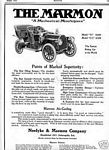 |
||||||
|
Marmon Motor Car Company Marmon was an automobile brand name manufactured by Nordyke Marmon & Company of Indianapolis, Indiana, from 1902 through 1933. Marmon's parent company was founded in 1851 manufacturing flour grinding mill equipment, and branching out into other machinery through the late 19th century. Small limited production of experimental automobiles began in 1902, with an air-cooled V-twin engine. An air-cooled V4 followed the next year, with pioneering V6 and V8 engines tried over the next few years before more conventional straight engine designs were settled upon. Marmons soon gained a reputation as a reliable, speedy upscale car. The Model 32 of 1909 spawned the Wasp, winner of the first Indianapolis 500 motor race. This car featured the world's first rear-view mirror. The 1916 Model 34 used an aluminum straight-6 engine, and also used the material in the body and chassis to reduce overall weight to just 3295 lb (1495 kg). A Model 34 was driven coast to coast as a publicity stunt, beating Erwin "Cannonball" Baker's record to much fanfare. New models were introduced for 1924, replacing the long-lived Model 34, but the company was facing financial trouble, and in 1926 was reorganized as the Marmon Motor Car Co. In 1929, Marmon introduced a sub-$1,000 straight-8 car, the Roosevelt, but the stock market crash of 1929 made worse the company problems. Howard Marmon had begun working on the world's first V16 engine in 1927, but was unable to complete the production Sixteen model until 1931. By that time, Cadillac had already introduced their V-16, designed by ex-Marmon engineer, Owen Nacker. Peerless, too, was developing a V16 with help from an ex-Marmon engineer, James Bohannon. The Marmon Sixteen was produced for just three years, with 400 examples made. The engine displaced 491 in³ (8.0 L) and produced 200 hp (149 kW). It was an all-aluminum design with steel cylinder liners and a 45° bank angle. Marmon discontinued automobile production in 1933, the worst year of the Great Depression. Marmon was notable as having introduced the rear-view mirror as well as pioneering both the V16 engine and the use of aluminum in auto manufacturing. When the Great Depression drastically reduced the luxury car market, the Marmon Car Company joined forces with Arthur (Colonel) Herrington, an ex-military engineer involved in the design of all-wheel drive vehicles. The new company was called Marmon-Herrington. In 1993, after an absence of 82 years, a Marmon Wasp car returned to the Indianapolis Motor Speedway in 1993 Indianapolis 500 to commemorate the 40th anniversary of The Marmon Group of companies. Eric Bachelart drove the car, actually a year old Lola with Buick power, which was uncompetitive and failed to make the race. After qualifications ended, the sponsorship was transferred to the car of John Andretti, who was driving for Indy legend A.J. Foyt Enterprises. Andretti started 23rd and advanced to the front, leading a few laps before eventually finishing tenth. |
||||||
| Vehicle Makes | ||||||
| Aero Willys American Motor Company Auburn Autocar Truck Buick Cadillac Chandler Chevrolet Chrysler Cole Aero Desoto Dodge Edsel Elmore Ford Franklin Frazer GMC Graham-Paige Hudson Locomobile Marion Marquette Mercury Mitchell Nash National Motor Oakland Oldsmobile Packard Paige Peerless Pierce-Arrow Plymouth Pontiac Reo Studebaker Stutz Whippet Willys-Knight Willys-Overland HOME |
 1905 Marmon |
1906 Marmon |
1906 Marmon |
|||
|
1906 Marmon |
1907 Marmon |
1907 Marmon |
||||
|
1909 Marmon |
1910 Marmon |
1910 Marmon |
||||
|
1911 Marmon |
1911 Marmon |
1912 Marmon |
||||
|
1912 Marmon |
1913 Marmon |
1913 Marmon |
||||
|
1914 Marmon |
1915 Marmon |
1915 Marmon |
||||
|
1917 Marmon |
1917 Marmon |
1917 Marmon |
||||
|
1918 Marmon |
1918 Marmon |
1918 Marmon |
||||
|
1918 Marmon |
1918 Marmon |
1919 Marmon |
||||

























